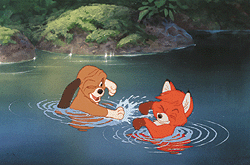|
|
ANIMATION WORLD MAGAZINE - ISSUE 5.8 - NOVEMBER 2000
|
Mark Dindal's Place in the Sun
For sheer entertainment value and as a beautifully animated film, Cats Don't Dance holds its own with any of Disney's contemporary releases. Unfortunately, Warner Bros. somehow decided the film wasn't worth its time of day, and after a cursory theatrical run and video release it dropped off the radar screen of public awareness. (It can still be found in the video stores, usually with me nearby trying to convince total strangers to rent or buy it.) Let's Get Talking Joe Strike: So how did you get into this line of work? Mark Dindal: As far back as I can remember, this was just something I wanted to do. Through grade school, high school, I just drew. I collected all the Disney books and any sort of animation books I could, which weren't very many at that time. I remember the one with Mickey on the cover holding a paintbrush. [Christopher Finch's The Art of Walt Disney.] Then I was lucky that my guidance counselor's secretary had a nephew who went to CalArts. She just happened to overhear a conversation and recommended it, so I came out with my dad to visit the school and ended up going. That was just a dream come true, because there was still Ken O'Connor, the layout man, Elmer Plummer, all these Disney veterans who were teaching at the time, so I got a chance to be exposed to them before they retired.
After a couple years there at the school I got offered a job as an effects animator on The Fox and The Hound in 1980. Ken O'Connor helped me out a lot; even though his specialty was layouts, he knew a lot about the effects world as well and really was my mentor through that. That's how I got into Disney. The effects department wasn't very big at that time -- about 5 people total. I stayed with that for quite a while, working my way up through the ranks until I was the effects supervisor on The Little Mermaid and ran the department. JS: I'm trying to find the point where you made the leap from effects animation -- which could be a possible career dead end if you get too good at it -- to working with character and story development which is a whole different area. MD: What I think was good about being in effects was in that capacity you were involved in all the phases of production quite a bit. Maybe not so much storyboard, although we could sit in on storyboard pitches to anticipate the work that was coming. You got the chance to see the production in both directions: the production part as well as post-production. So it gave me quite an awareness of what everybody does, which I think is important as a director, to have some knowledge. I couldn't tell you everything that they do, but at least I know the main gist of what they have to do, so it was a good path by which I ended up here. JS: Was there some point where you had to show somebody, 'I can animate a character, I can get an emotion across?'
|
||||
|
|

